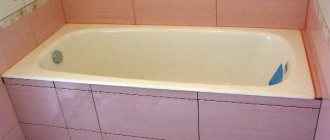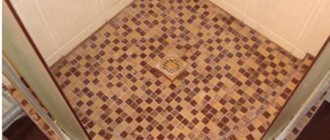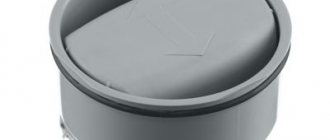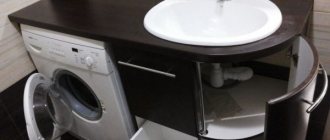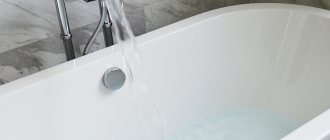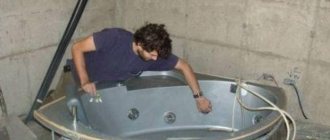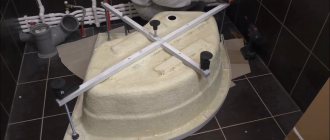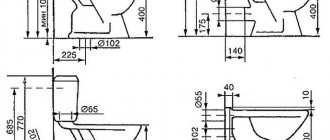In this article I will tell you what a shower drain and shower tray are, and also share my experience in choosing and installing them. If this is your first time on my website, I’ll introduce myself: my name is Evgeniy.
I am an installer of heating, water supply and sewerage systems. I work mainly in private homes; you can get to know me in more detail on the “about the author” page.
A shower drain or tray is a device for collecting water from the floor surface and then discharging it into the sewer. They are called showers because they are often used in showers made using construction methods.
This is when the drain hole is in the floor, the grate is installed flush with the tiles, and the water goes into it when you bathe in the shower.
What is the difference between a ladder and a tray?
In simple terms, a shower drain differs from a tray in size and appearance. A drainage device with a square or round grate is called a drain. A shower tray is a drainage channel with a rectangular grille.
Since the trays have a larger grid area, they also have a larger area for collecting water from the floor. Many people think that if the shower tray is larger than the drain, then the water will flow into it faster. However, this is not quite true. I'll explain why a little later.
Which is better: shower drain or tray?
When customers ask me: Zhenya, I want to install a shower drain in the floor, tell me if I should install a tray or a drain? I usually answer them like this: If your shower is built using a construction method or a shower cabin without a tray, then it is best to install a tray.
It costs more, but it also looks beautiful. If you have a shower with a tray, then I recommend installing a drain in the bathroom. It will come in handy if the flexible line bursts and water starts gushing out of it.
When purchasing and selecting a tray or ladder, be sure to ensure that it has a dry seal. Now I will explain what it is and why it is needed.
Dry seal for sewerage
Dry shutter. Photo Petrovich
Systems for the reception and disposal of wastewater and liquid waste are an essential element of structures for various purposes. One of the components of the systems is the shutter. Until recently, the most popular option was hydraulic seals (wet, water or hydraulic seals).More
Gangways
Technical device
The design of the drain resembles a glass, in the lower part of which a pipe is welded, which is connected to the sewerage system. The tray, as you may have guessed from the name, has a design reminiscent of a rectangular container. And also at the bottom there is an exit for connection to the sewer pipe.
There are 2 types of outputs: vertical and horizontal. Ladders and trays with a vertical outlet are installed in cases where sewerage pipes run on the back side of the ceiling. With a horizontal (side) exit they are placed where the sewer pipe runs along the same side of the ceiling.
I'll give you an example so you don't get confused. I need to install a drain or tray in a bathroom on the first floor of a private house. If I install a device with a horizontal outlet, I will have to pour a large layer of screed, which should hide the sewer pipe.
Or you can drill a hole in the ceiling and install a drainage gutter with a vertical outlet. And run the sewer pipes along the ceiling of the basement.
In this case, the screed layer on the first floor will need to be poured much less. This is savings. And saving means earning money.
What is a water seal
Each device that is connected to the sewer is equipped with a water seal by default. Sometimes it is also called a wet shutter. Have you seen water standing in the toilet or in the siphon under the sink? This is a water seal.
It is needed to prevent odors from the sewer from penetrating into the room. As long as there is water in the water seal, it will not allow odors to pass through. But as soon as the water evaporates, the room will immediately begin to smell like sewage.
If water takes a long time to evaporate from the toilet or siphon, then water will evaporate from the drain or tray quite quickly. Especially if there is a warm floor nearby. While people bathe in the shower every day, the water seal will trap gases from the sewer.
But as soon as you go on vacation or stop using the shower, the water from the water seal will evaporate and the room will smell. To get rid of this problem, they came up with a dry shutter.
What is a dry shutter
A special valve is built into the design of the drainage device, which opens under water pressure, closes when there is no pressure and does not allow odors to pass through. Valves can be either reed valves or ball valves.
The second ones, it seems to me, work better. The water level dropped, the ball sank under its weight and closed the sewer hole. If water enters the gutter, the balls float.
But reed valves, in my opinion, work worse. After a while, the elastic band becomes “oaky” and stops fitting tightly. If the reed valve is plastic, it may begin to jam in the hinges after a few years.
I note that removing and washing the valve takes 10-15 minutes. So this is more of a quibble on my part than a compelling argument in favor of dry ball valves.
Which is better: a water seal or a dry seal?
I always recommend purchasing a tray or drain with a dry seal. It costs a little more, but protects against sewer smell much better. I am a supporter of the valve with balls, although if the valve blades are made of plastic, then they will work for a long time and without problems.
How to properly lay drains in the shower?
We are installing a new shower in the summer house. How to install shower drains yourself?
The sewer drain must be assembled from plastic parts, or from metal parts, the main thing is that it is not subject to corrosion.
The main functions of a sewer drain in the shower are to protect the room from various unpleasant odors; also, the sewer drain prevents clogging and pollution of drain water.
Sewer drains can come in different shapes and configurations.
Sewage drains can be point, linear, or attached.
The point type can be placed in almost any part of the shower, but the linear and attached ones should be placed along the edges of the shower, or in the corners.
Types of drains and trays
Conventionally, they can be divided into 3 types:
Spot
This is a small drainage device with a round or square grid. They are most often called ladders.
Linear
This is a sewer gutter with a rectangular cross-section grate. Sometimes manufacturers, instead of the usual decorative grille, make a tray cover onto which tiles can be glued. Then the tray is almost invisible, and the water goes into the cracks. Therefore, such drainage gutters are called slotted.
Wall-mounted
There are trays that are mounted into walls. Then the water you are bathing under goes into the corner of the wall or into the wall. Therefore, this drainage gutter is often called a wall gutter.
A shower with an inconspicuous tray looks more beautiful, but you will have to pay extra for beauty. Wall drainage gutters are often more expensive than point or linear devices.
Sometimes for wall trays you need to install a separate installation.
What to look for when choosing
When choosing a shower tray or drain, I recommend setting a budget. You can buy a tray for 5,000 rubles, or you can buy it for 80,000 rubles.
However, in terms of characteristics they will be approximately the same. Below I will write my rating of ladders and chutes based on my experience working with them.
If you don’t want to stand ankle-deep in water while taking a shower, then you need to determine the water flow rate from the shower in the bathroom. I had a situation where I installed a tray for water drainage for a man.
And then he installed a rain shower, and the water did not have time to go into the drain hole in the floor. To replace the drain, the tiles would have to be broken, but the customer did not want that.
Even at the stage of installing the sewer system, I told him several times to decide on the shower system so that I could calculate the drainage system. And he waved it off and said that later he and his wife would buy a drain and a shower. So I bought it. Well, at least he had no complaints against me, he understands that he himself is to blame.
We are currently building a lot of frame houses. But they don’t sell ladders for framers. There is a wide variety of them abroad, but no one brings them to us. I don't know what this is connected with. Therefore, ladders and trays designed for installation in the screed have to be built into frame floors.
Stainless steel or plastic
I often meet customers who are sure that a stainless steel shower drain or tray is the best. I have the opposite opinion. I believe that the body of the ladder or tray should be made of plastic.
Stainless steel is steel that contains chromium. It is the layer of chromium oxide CrO that makes steel stainless. When people bathe in the shower, they use household chemicals (shampoos, shower gels, etc.).
Who knows how and how long it will take for these substances to damage the chrome coating? That's right, no one knows this. And as soon as the chromium oxide layer is damaged, the stainless steel will immediately begin to rust.
But this does not threaten the plastic body of the tray or ladder. I met customers who said that plastic is fragile, but you definitely can’t break stainless steel. I don’t know how to argue with such people; in my life I have never seen a drainage channel body break after installation.
If a tray or ladder is built into concrete, then it is practically one piece with it. You can probably break the body with a hammer, but with your foot, even jumping on it, it’s unlikely.
If the body of the drainage device is built into the frame ceiling, then it is also unlikely to be broken. Provided that the ladder or tray is installed correctly and according to the instructions.
Installation nuances
When I install a sewer system in a private house, I always make sewer outlets below the ceiling and always install covers.
If the sewer outlet is below the ceiling and there is a case, then bringing the sewer system to the required height at the end of the repair is as easy as shelling pears.
When there is no case, you will have to break the tie to install the ladder. And the sewer pipe will most likely have to be replaced, since during construction workers step on the sockets of sewer pipes and break them.
Is it possible to install a drain in an apartment?
I have had orders where people wanted to choose a floor shower drain under tiles, but did not know whether it could be installed in an apartment building.
The drain in the apartment is simply installed, but be prepared for the level of the screed to rise. Again, I repeat that a ladder or tray with a side exit is suitable for an apartment.
Where should the ladder be in a private house?
The boiler room of a private house must have a drain in any case. I know several people who refused to install it and then regretted it.
Watch the video where we explained why every boiler room should have a drain.
All equipment containing water is collected in the boiler room.
This is an indirect heating boiler , buffer, boiler, collectors, pumps, etc. Every home has some of this. Sooner or later this equipment must be serviced or repaired.
To do this you need to drain the water. If there is no ladder, you will have to run around with rags and basins to remove spilled water from the floor. And if you have an indirectly heated boiler or a ton-sized buffer tank, then you have to bother with hoses to somehow drain the water.
And so the drain valve was opened and all the water drained into the drain. The boiler room must have a drain to the floor anyway.
Installation of tray and ladder
I will say a banal and obvious thing: whoever will install the drainage device must read the instructions for it. Usually everything is written there in clear and accessible language, what, how and in what sequence needs to be done.
Video of step-by-step installation of MIANO shower tray
Most importantly, do not forget to waterproof and maintain the slopes of the sewer pipes.
Watch the video to see 7 mistakes made when installing sewer systems.
But if you still have questions, write them in the comments. Perhaps then I will edit this article and write step-by-step instructions for installing a drain and shower tray with pictures or make a video.
Installation features
Installation diagram
The gratings are installed at the level of the floor covering. The joints are grouted with moisture-resistant material. The outlet pipes are installed at a slope of 0.1% relative to the length. The screed is removed when installing drain funnels. It is equally important to seal each joint and all joints, and perform thermal and waterproofing.
Features of installing a drain in a shower room:
- The thermal barrier is placed around the circle of plumbing drains.
- When creating a stretch, constantly monitor the slope of the pipes. After completion of the work, the raw concrete is leveled and tiles are laid on it.
- In order for water flows to be directed to the drain, it is necessary to make the floor covering slope in the desired direction by at least 150 mm.
- Expanded polystyrene with a thickness of 40 to 50 mm is laid on the bottom. Insulation reduces noise and prevents heat loss.
- A rough screed is being made, for which you will need to pour another 4 cm of concrete mortar. A waterproofing membrane is laid on it, and then a slope-forming screed and ceramic tiles.
- Wall cladding is carried out only after laying, which allows you to achieve an optimal level of waterproofing.
When choosing a drainage device, you should pay attention to the durability of the material from which it is made, and also take into account the features of its use in the future.
Rating
My rating contains water drainage devices only from those manufacturers whose products I have ever installed. Based on my experience, I can say that European manufacturers all make good products; when purchasing, you need to look at the price and equipment.
And so they are more or less all the same. I do not recommend purchasing cheap Chinese and Turkish trays and ladders. Replacing a drain costs 10-20 times more than the cost of the product + installation. I think it is better to initially buy a higher quality product.
My rating of point drains
Shower drain Tim BAD011002
This product has 2 advantages:
- Low cost, about 500 rubles;
- Small height - 67 mm.
Among the disadvantages: the ladder must initially be set exactly at the height of the finishing floor covering. No dry shutter. Of the 4 drains purchased by the customer, 3 leaked at the welding site. Maybe it was a defective batch, but I installed these ladders only once and didn’t risk it again.
Bath drain, shower drain TECE S110
Several times we had to install such ladders. When purchasing, you need to look at the package. The set may not include legs and a dry siphon. I can’t say anything bad about this ladder, but, in my opinion, the price is a bit high.
Drain drain AlcaPlast
The Czech manufacturer AlcaPlast produces many products for draining water. Among everything I've put on, this is a solid average. On the one hand, the plastic is flimsy, on the other hand, there have never been any problems with these ladders and trays.
Point shower drain Aco
These products are of high quality with an increased throughput of up to 120 liters per minute. Suitable for any rain shower. The cost is also high. I installed them several times, but they were strong and reliable, but expensive.
Viega Advantix shower drain
I like these ladders most of all due to the price-quality ratio. That's why I installed them most in my life. I don’t know the exact number, but I definitely supplied a couple of hundred pieces. There are no problems with them. Dry shutter included. The plastic is strong.
My rating of shower trays
Drainage channel AlcaPLAST Simple
Pros: good quality plastic. Waterproofing tape included. Combined siphon, when water evaporates, no odor will appear in the room.
Disadvantages: I didn’t like how the legs were adjusted. Low flow rate: 28 liters per minute. I wouldn't install one like this for a rain shower.
Gutter trays ACO (Ako)
They are made in Germany from high quality stainless steel. This is a premium brand, so they are relatively expensive, but there are several budget models. I only installed this once. I can't say anything bad.
Drainage channel TECE TECElinus
They also make it in Germany and the price is also high: trays from 15 thousand rubles and a grill will cost another 5 thousand. I can't say anything bad, but it seems to me that the price is too high.
Shower tray Viega Advantix
Made in Germany. Drainage channels were made of stainless steel or plastic + stainless steel. Good quality. I have never had any problems with the products of this brand, I recommend it for purchase . But the price tag is also not cheap and starts from 15 thousand rubles.
MIANO gutter trays
Over the last year I have been recommending them to all my customers. Made in the Czech Republic. The plastic is strong. There are cases in charcoal black, which looks cool. Everyone usually has gray plastic.
Drainage channel complete with water seal and dry seal. High flow rate: suitable for rain showers.
Convenient adjustment of legs during installation. They can be twisted directly through the body with a screwdriver. This speeds up installation of the tray significantly.
Waterproofing included. At the same time, the price tag is average. In my understanding, these gutters are ideal in terms of price-quality ratio.
I buy MIANO shower trays in the Akvamosaika online store ; these products are not sold in offline stores in my city.
Types of materials for equipment production
In accordance with the material from which the drain parts are made, the following types of products are distinguished:
- cast iron has the largest capacity, but is heavy and difficult to install. Can be used in difficult conditions. Used in factories, swimming pools, public toilets;
- plastic ones are resistant to aggressive influences, weigh little, have low cost, are durable, and do not require special operating conditions. Polymer products are widely used when installing a do-it-yourself drainage system for various sanitary facilities;
- Stainless steel drains are used in premises where it is necessary to ensure compliance with high sanitary requirements: hospitals, kindergartens, catering establishments. The metal body is easy to clean from dirt, and the products are easy to install.
Plastic ladder
Lorem ipsum dolor sit amet, consectetur adipiscing elit, sed do eiusmod tempor incididunt ut labore et dolore magna aliqua. Ut enim ad minim veniam, quis nostrud exercitation ullamco laboris nisi ut aliquip ex ea commodo consequat…
Stainless steel drain
Cast iron horizontal drain
To install a drain system for a shower stall with your own hands in an apartment or house, it is recommended to use plastic or steel products.
Conclusion
In this article I shared my experience and opinion, which is very subjective. I have ordinary customers, so I rarely supply premium products.
I always try to balance price=quality.
You can safely choose products from a popular and well-known European brand and it will work for you for quite a long time.
Don't go for the cheap stuff. When you make a shower drain in the floor and water leaks somewhere under the tiles, dampness and fungus will appear. This will be quite expensive to fix. As I already wrote above, replacing a tray or drain costs several tens of times more than the cost of the product and the work to install it.
I wrote my reviews about ladders and trays and talked about the nuances. If you found the article useful, please like it and ask your questions in the comments.
